Dirt, salt and roses
The color alchemist leads fashion way, way back to its roots – and toward a sustainable future
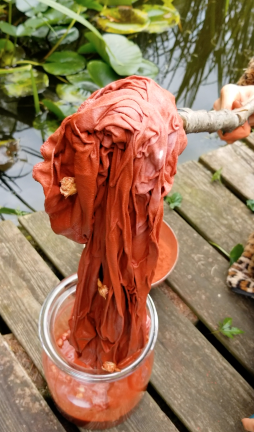
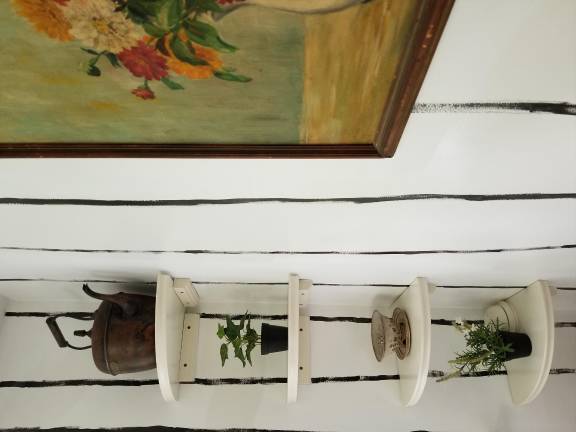
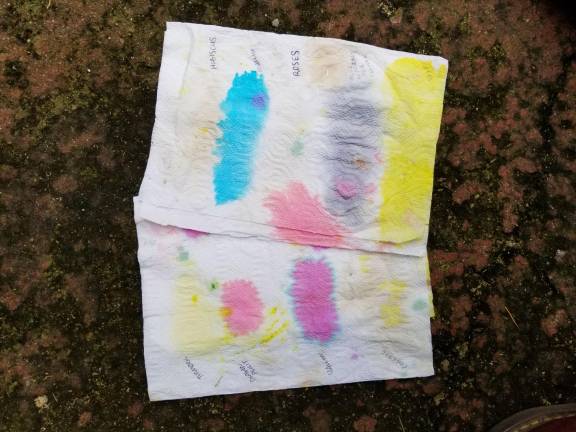
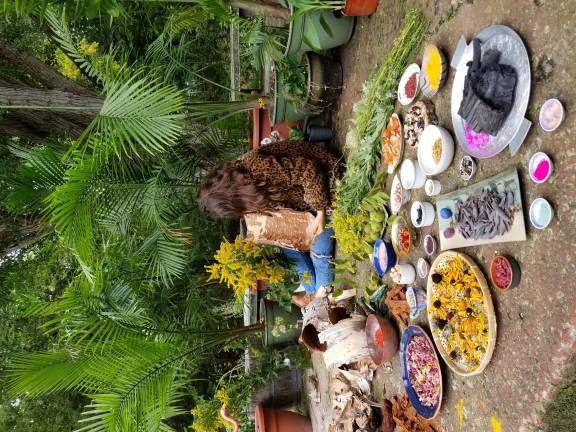
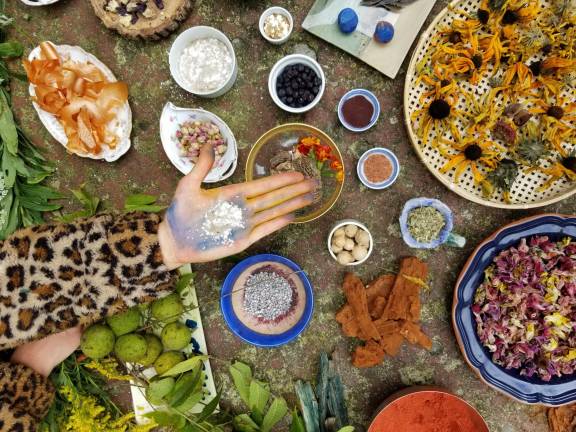
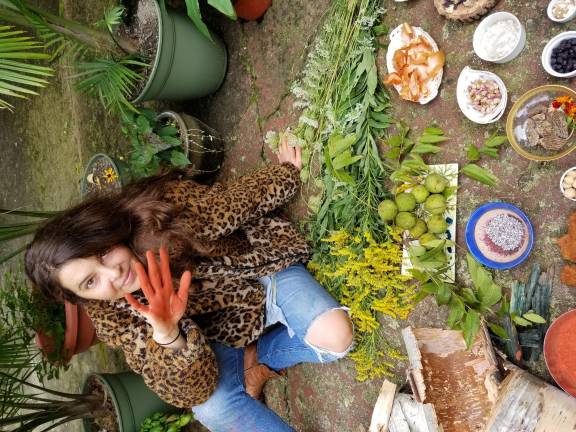
“The most exciting change in my daily life from living in Brooklyn,” said Audrey Louise Reynolds, who recently moved to Warwick, “is the fulfillment I’m getting from being completely a kid in nature.”
Take the blue wood she found in Wawayanda State Park. The bark is enveloped by Chlorociboris aeruginosa, a blue-green cup fungus that usually manifests as a green stain on its host species. “I started rubbing it on my shoe like a crayon, and it turned my shoe this blue-green,” said Reynolds. “So I filled my pockets with it.”
Her eyes light up when I ask about Tyrian purple, which is produced by boiling snails and is the most expensive textile dye on the planet, pricier than gold. Reynolds excitedly unearths details about the shell-bearing creatures for my novice ears. “But really,” she concludes, “can I start a snail farm?”
Starting a snail farm doesn’t seem far out of the range of possibilities at Reynolds’ new setup. Her 1870 farm-style house, where she has relocated after 15 years in Red Hook, Brooklyn, adjoins 100 acres of wilderness. It’s airy and light, her walls adorned with abstract pieces by Peter Sutherland, Anthony Lister, and Judith Supine; her curly white Lagotto Romagnolo companion, Damo, is excitable and ready to make friends. Most rooms are painted with vertical stripes. All the paints – home-grown fermented indigo, burned bones black, light purple local berries, foraged green earth – are made by Reynolds.
Reynolds has always been on this course. When she was three, she painted the walls of her family’s home with turmeric. In high school, she customized skate decks and shoes for friends. Her father worked in the automotive industry, and, when she was a child, “He even showed me the difference between blue-black, red-black and yellow-black,” she recalled. “I remember bags of shredded plastic bottles that were to become car textiles and running my hands through these silky-smooth confetti-like pieces.”
Reynolds studied painting at the School of the Museum of Fine Arts in Boston, where she also worked as a line cook. The intersection of her work and studies eventually brought her to a bigger realization: she could manipulate food to create color that was less harmful than the toxic paint she used in her classes, and if she could do it with food, she could certainly use any organic matter. That was in 2002. Today, Reynolds is at the leading edge of the sustainability and fashion conversation.
Two years after she graduated, the late British designer Alexander McQueen discovered Reynolds and commissioned her to make materials for his collections, such as pigments from sumac, spinach and blue butterfly pea flower. Socially conscious designers Rogan, Loomstate and No. 6 followed shortly, hiring Reynolds to dye seasonal collections. She found herself in an experimental frenzy in her small Brooklyn apartment, creating pieces with burnt fabric, making paint from recycled tires and smashing nuts onto textile.
Dirt, plants and compost form the foundation of Reynolds’ palette. Since 2008, she has been focused on nature-based color. That’s when she eliminated all synthetic mordants, which are used to fix color. Excluding these from the dye process is a challenge, but she discovered effective alternatives in salt, algae, soy binders and through use of fermentation. Reynolds founded her company on the concept of dermal absorption, bringing attention to the fact that chemically dyed clothing can harm human health, while the medicinal qualities of nature-based dye can actually be good for us.
Dye can be good for the environment, too. Sasha Duerr, a natural dye educator at California College of the Arts, designs irrigation systems for gardens and house plants from leftover natural dye, which in turn nourishes plants with the vitamins and minerals from the ingredients. She writes in her how-to book, Natural Color: Vibrant Plant Dye Projects for Your Home and Wardrobe, “The process of ... creating colors from nature [is] directly related to our ecological literacy.”
Dye waste in the conventional garment industry is another story. According to the World Bank, 17 to 20 percent of industrial pollution comes from textile dye. A 2013 New York Times article, Bangladesh Pollution, Told in Colors and Smells, revealed the realities of a fatal factory collapse that briefly brought the western world’s cut-rate fashion industry to our attention. It underscored the intensity of pollution from textile dye mills – located in poor communities vulnerable to climate change – with photos of waterways in shocking hues.
Reynolds is determined to bring change to the textile industry, combining her unique skillset with environmental advocacy. Over the past decade, she has traveled to Bangladesh, China and Turkey to implement her natural dye techniques in factories.
Large-scale sustainable dye installation certainly helps, but change also starts with the individual consumer. Reynolds recommends that people “build a wardrobe of ethically sound garments, go to clothing swaps, and donate to people in need or foundations like HELPSY,” a B Corporation with an environmental mission to keep clothing out of landfills (you can find a bin location near you here). Purchasing secondhand and swapping can help ease the production demand. The U.S. Environmental Protection Agency estimates Americans throw away about 12.8 million tons of textiles annually, which amounts to about 80 pounds of clothing per person. Textile mills generate one-fifth of the world's industrial water pollution, according to the National Resources Defense Council.
Synthetic dye was introduced 160 years ago. Before that, all color in textile production was derived from natural ingredients, and the stories behind them are fascinating. Cochineal, a cactus-dwelling insect, jumpstarted the South American economy by way of crimson red in the 15th century. Indigofera tinctoria (also known as indigo) leaves have been used for their violet blue hue for 6,000 years, by ancient civilizations spanning present-day Africa, Europe and South America. Reynolds adores these age-old processes and uses them often in her own work.
As people have been doing since the dawn of civilization, Reynolds finds her way to color through curiosity, intuition and experimentation. She is no stranger to fermentation or distillation and balances her dye concoctions with heat, salt, time and agitation to manipulate colors exactly as she dreams them up. Last year, she custom dyed hand-spun cotton blankets with 100-day fermented indigo for NOMA Copenhagen, hailed as the world’s best restaurant, known for sourcing wild-harvested ingredients to connect eaters to the local terroir. Reynolds has her own line, ALR, selling clothing along with her handmade natural dyes at alrdyeing.com, and is currently featured in the Fashion for Good Museum in Amsterdam, where customers can purchase her one-of-a-kind clothing items.
Reynolds sources garments from small family-run cotton operations, one in Texas and another in Egypt. She likes to cater to customers who prefer a more local option as well as those who crave a more luxurious cotton. “I don’t have the answer to what’s the most sustainable,” she said, “but I can offer several options for my customer who is on that journey and wants to explore it with me.”
Reynolds agitates one of her shirts in an eyeballed concoction of dirt, salt and roses. She describes the tint as the color of Venus of Willendorf, a faceless female-bodied figurine made in Paleolithic Austria around 30,000 B.C., believed to be representative of fertility and a good luck charm. The color also brings cave paintings to mind. I ask if the dirt has a name. “It’s called Dirt I Found,” she says, and we both laugh.
Through Reynolds’ eyes there is a romance in the origin of color that connects us to another time, place, and struggle. “What’s your connection to the thing you’re making if there’s a layer between you?,” she asks, urging us to put our hands in the dirt and create.